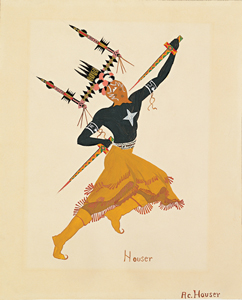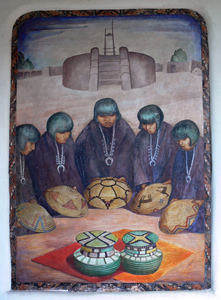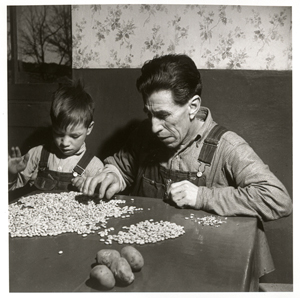In 1929 the stock market crashed and the United States entered the great Depression. The tourism market in New Mexico crashed as well, and a period of prosperity for artists ended. Educational and vocational programs were developed to promote artistic and economic development in the state.
 The Spanish Colonial Arts Society and the Colonial Hispanic Crafts School, in Galisteo were both formed in 1929 with the goal of encouraging and promoting traditional Hispanic arts. Traditional arts such as weaving, furniture making, tinwork, colcha embroidery and wood carving were taught and promoted. Taos and the smaller villages of Northern New Mexico were the centers for these activities, and both traditional and modern artists, philanthropists, intellectuals, and writers were involved in promoting interest in Hispanic arts. Romero de Romero became the best known Hispanic painter from New Mexico during this time.
The Spanish Colonial Arts Society and the Colonial Hispanic Crafts School, in Galisteo were both formed in 1929 with the goal of encouraging and promoting traditional Hispanic arts. Traditional arts such as weaving, furniture making, tinwork, colcha embroidery and wood carving were taught and promoted. Taos and the smaller villages of Northern New Mexico were the centers for these activities, and both traditional and modern artists, philanthropists, intellectuals, and writers were involved in promoting interest in Hispanic arts. Romero de Romero became the best known Hispanic painter from New Mexico during this time.
 In 1932, Dorothy Dunn created the The Studio Program at the Santa Fe Indian School. Dunn was an art educator who felt that art instruction helped her Native American students master English and achieve academic success. She taught her students a painting style based on ledger drawings, Kiva murals and first generation Pueblo easel painters. She encouraged students to depict their cultural traditions and lifeways by using flat outlined forms, without 3-D perspective or modeling. Though the aesthetics were narrowly defined, Dunn’s students included the likes of Allan Houser and Pablita Velarde. The Studio program was a success and the new style of painting became a powerful force in New Mexican art. Dunn was succeeded by one of her students Geronima Cruz, and the program was continued until it was replaced by the Institute of American Indian Arts in 1962.
In 1932, Dorothy Dunn created the The Studio Program at the Santa Fe Indian School. Dunn was an art educator who felt that art instruction helped her Native American students master English and achieve academic success. She taught her students a painting style based on ledger drawings, Kiva murals and first generation Pueblo easel painters. She encouraged students to depict their cultural traditions and lifeways by using flat outlined forms, without 3-D perspective or modeling. Though the aesthetics were narrowly defined, Dunn’s students included the likes of Allan Houser and Pablita Velarde. The Studio program was a success and the new style of painting became a powerful force in New Mexican art. Dunn was succeeded by one of her students Geronima Cruz, and the program was continued until it was replaced by the Institute of American Indian Arts in 1962.
Federal Arts Projects
 The PWAP (Public Works Arts Project) and the WPA (Works Progress Administration) were created during this time to support unemployed artists throughout the country. In New Mexico,160 artists created public art in 29 New Mexican communities . Will Shuster created 4 large murals to honor Pueblo Indians at the Museum of Fine Arts, through the short-lived PWAP. The WPA supported a wider range of projects in public buildings and supported artists and craftsmen making prints, paintings and photographs, as well as traditional Hispanic and Native American artworks.
The PWAP (Public Works Arts Project) and the WPA (Works Progress Administration) were created during this time to support unemployed artists throughout the country. In New Mexico,160 artists created public art in 29 New Mexican communities . Will Shuster created 4 large murals to honor Pueblo Indians at the Museum of Fine Arts, through the short-lived PWAP. The WPA supported a wider range of projects in public buildings and supported artists and craftsmen making prints, paintings and photographs, as well as traditional Hispanic and Native American artworks.
FSA, or Farms Security Administration photo project
 The FSA, or Farm Security Administration, hired photographers to document rural American lives during the Depression. John Collier Jr. and Russell Lee photographed in farming and ranching communities, small villages and along the highways crossing the state. Their documentary work has inspired many photographers who focus on the vernacular- on the everyday life of distinct American cultures and communities.
The FSA, or Farm Security Administration, hired photographers to document rural American lives during the Depression. John Collier Jr. and Russell Lee photographed in farming and ranching communities, small villages and along the highways crossing the state. Their documentary work has inspired many photographers who focus on the vernacular- on the everyday life of distinct American cultures and communities.
